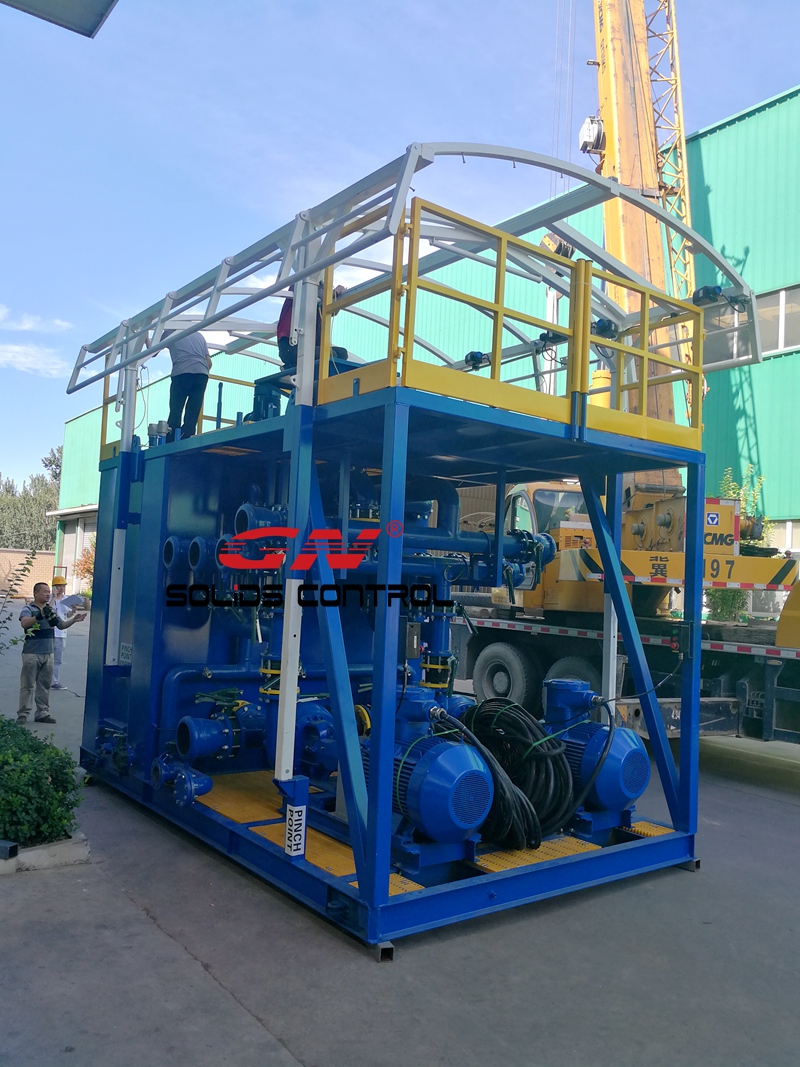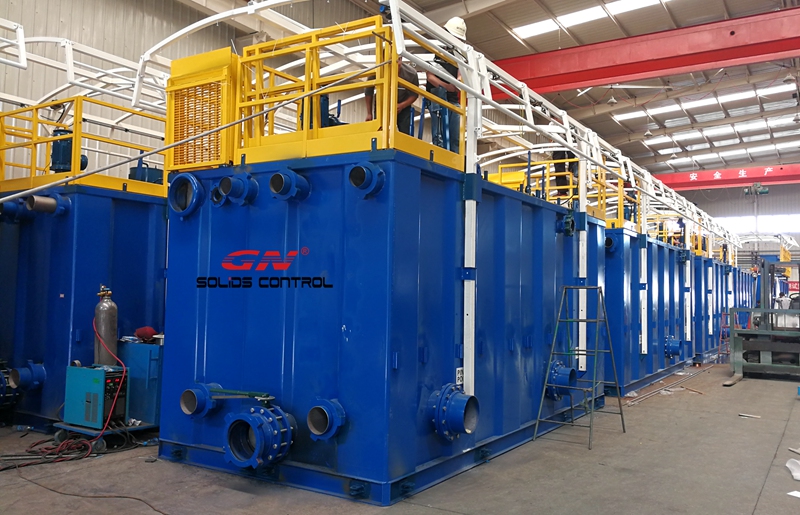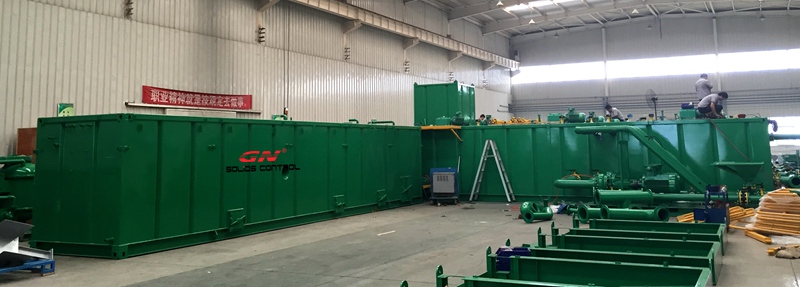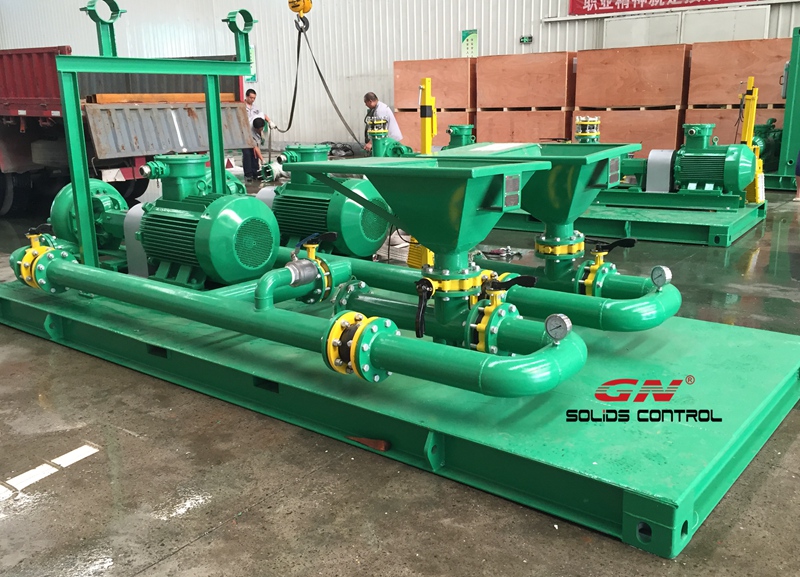
After 2-months hard working, finally, GN Solids Control dispatched the full set helicopter lifting mud tank system. The total system including 11 modular as below:
1) There are 9 ea full functional mud tanks, complete with pipelines, walkways, ladders, guards, vales, electrical control systems, sun & rain sheds, and other necessary accessories.
2) 2 ea transportation frame for equipment and spare parts lifting and shipment.
It is a very special and difficult project. Every design, no matter how small, showed be caculated carefully, every spare parts and accessories should be chose from famous brand. Every design is new made, while the leading time is very very tight. Normally, for this kind of project, it should take a couple of months only to make sure the design drawings, not consider the manufacturing. But as the end user have strict time schedule, it cannot be changed. In order to support client for the project, GN people works for 7 and 24 hours, and finally finished the while system within a short time. 
Why we say this oil rig mud system is very special and difficult? Below is some features of the system:
1) As the whole system is designed for helicopter lifting standard, the total weight of every single modular should be not more than 9 tons, but it is on condition that the storage volume and strength should be strictly ensured.
2) Furthermore, as the reason of safety and to comply with the HSE standard, every modular must be strong enough for helicopter lifting. And the lifting point should be specially design to suit for helicopter lifting. It must be strong enough and should be keep balance during lifting. Every design should come from strict calculated.
3) Every components of this mud tank system are chose from high quality and famous brand, like valves, unions, bearings, lights, motors, paint, etc…
4) All pipelines are made from SS316L for longer lifetime.
5) All welding jobs of this system should be complied with ASME standard, and should be tested by NDT.
6) Coating & Painting are chose from worldwide famous brand PPG
This projects give GN much experience on helicopter lifting system design and manufacturing. GN can offer more professional and fast supporting for any new helicopter lifting project in the future. Welcome customers contact GN Solids Control for any inquires.
- Details
-
Published: 11 August 2017
500GPM is a most popular size mud recycling system for HDD and water well drilling rigs. Recently, GN Solids Control dispatched a full 500 GPM mud recycling system for a VIP customer. This is the 4th mud system for this customer. They will use the system to match their Horizontal directional drilling rigs (normally called HDD rigs) for construction field.

The system is combined with below equipment:
1) 1 set linear motion shale shaker GNZS594E-HB with 528GPM capacity. It is a 4-panel shale shaker with GN special design composite material screens. The composite material screen lifetime is nearly more than double compared with the old type metal frame screens. But GN composite material screen price is just a little bit higher than the old technology metal frame screens.
2) 1 set mud cleaner combined with a underflow shale shaker, 10 inch desander cones and 4 inch desilter cones. It contains 2 stages separation. The mud cleaner can remove solids above 27microns.
3) 2 sets centrifugal pumps are used to feed for the desander and desilter. The centrifugal pump is GN upgraded design. The impeller and pump casing is made from wear-resistance material for longer lifetime and to suit for hard materials. Furthermore, the centrifugal pump design is interchangeable with Mission Magnum pump. Even all the spare parts are interchangeable with Mission Magnum pump. So many customer can order GN centrifugal pump to replace their old Mission pump and order spare parts from GN.
4) 1 set of mud tank complete with pipelines, walkways, guardrails, ladders, electrical control system, lighting system, etc… The mud tank is with the same dimension of a standard 20ft container. All clean gate, values, etc… are insert type in avoid oversize. It can avoid to destroy any tank wall accessories during shipment. And customer can use standard container track for shipment.

5) A 20ft containerized skid for fast movement and easy lifting. The skid is used to mount shale shaker and mud cleaner. All pipelines are connected by fast connectors for east install and remove.
- Details
-
Published: 04 August 2017
As a leading brand GN Solids Control will come for SPE Offshore Europe this year. The time of the show is 5th ~ 8th Sept. It is the first time GN Solids Control comes for SPE Offshore Europe. But GN Solids Control already has a good sales record for UK and for Europe.
GN Solids Control will take the high quality replacement screens for SPE Offshore Europe exhibition. GN Solids Control makes high quality replacement composite material shaker screen for most of the popular shaker models, like for Derrick shakers, Swaco shakers and Brandt shakers.
SPE Offshore Europe is the leading exhibition for Engineering and petroleum on oil & gas field. Around 50000 visitors and over 1000 exhibitors from +150 countries will come for the show. The SPE Offshore Europe will be hold at AECC (Aberdeen Exhibition & Conference Centre), Exhibition Avenue, Bridge of Don, Aberdeen, AB23 8BL. It is a good chance for the petroleum field suppliers to meet with his potential customers, to communicate with their peers. And it is also a good chance for the suppliers to know the new trend and development of this field.
Besides the SPE Offshore Europe exhibition in UK, GN Solids Control will come for all the international big oil and gas field exhibitions, and many professional exhibitions in certain regions. Below is the exhibitions GN Solids Control will come and already came for:
1) CIPPE oil show in Beijing in March, It is second largest oil show in the world.
2) OTC oil show in March in Houston. GN Solids Control and GN Solids America comes for OTC oil show for over 5 years. GN Solids America is the 1rst Chinese solids control brand open brand company in USA.
3) MIOGE exhibition in Moscow in June. It is the largest exhibition for Russian countries.
4) ADIPEC in Nov. in Abu Dhabi. UAE is a center city for petroleum field. Most international huge oil company, drilling company, petroleum company and services companies, they will open offices in UAE. Visitors and exhibitors comes from Middle East, Africa, East Asia and Europe comes for the big event.
- Details
-
Published: 28 July 2017
Weeks ago, GN Romania partner accompanied the end user, a drilling rig contractor in Romania, came to GN Solids Control main factory in Beijing China, to check their full set mud solids control system for their new rig. It is full set mud solids control system for their 1000hp oil rig. The system is made per CE standard for European market. The electrical system is also made per European standard ATEX.
They checked the quality and the performance of the mud solids control system, and very happy with GN products. After their check, GN Solids Control logistics team dispatched the system to the Tianjin seaport for international ocean shipment.
It is a full set mud solids control system with 3 stages solids control process and 4-stage treatment.
The first step solids control process is 3 sets linear motion shale shaker, GNZS594E. It is GN latest design 4-panel shale shaker. And it is one of the most hotel sale equipment model from GN. The shaker deck is made from stainless for longer lifetime. Vibration motor is choose from Italy Oli (US Martin is available if client request).
The second step and the third step is by mud cleaner, it is combination of linear motion shale shaker, desander and desilter. The underflow shale shaker is the same with the 1rst step solids control shale shaker for spare parts interchangeable.
Furthermore, the 1000hp oil rig mud solids control equipment is equipped with below equipment:
1) 1 set of vacuum degasser. GN special design vacuum degasser is self-suction type.
2) 2 sets of centrifugal pump feeding for the desander and the desilter. The pumps are interchangeable with NOV Mission pump.
3) Dual hopper and dual pump mud mixing system, to mixing new chemicals for the system
4) 20 sets mud agitator for shale shaker tank, suction tank, mixing tank and storage tanks.
5) Mud tanks for the full mud solids control system, including trip tank, shale shaker tank, suction tank,
- Details
-
Published: 22 July 2017
GN Solids Control is a leading manufacturer and a famous international brand of waste management solution, like oily sludge separation system, contaminated soil clarification system, waste oil recovery system, waste water recovery system and other liquid and solids separation plant. GN Solids Control has branches in many major markets, like GN Solids America in Houston America, GN Solids Russia in Moscow
Weeks ago, GN Solids Engineers came back from a Middle East oily sludge separation jobsite. They finished the job there for a commissioning of a separation plant to treat oily sludge and the contaminated soils from oil and gas drilling activities.
The end user let a U.S consultant company to choose the right suppliers for their projects. Other compare various brand, they compare their solutions and their experience on similar jobs, finally, the U.S consultant company choose GN Solids Control.
Based on the oily sludge condition, and the client requirement, GN Solids Control offer them a customized solution. Before the system sent to clients jobsite, the US consultant company sent engineer to GN Solids Control to check the system. They are happy with the system and approve the ship to the jobsite.
It is a complete oily sludge separation system including following treatment modular:
1) The pre-mixing and heating module. It is a mixing tank and agitator and transfer pump, and equipped with heating system.
2) Solids Control separation modular: it is including mud tank, high G drying shaker and decanter centrifuge separation system.
3) Chemical dosing modular. It is a 20ft containerized chemical dosing system for automatically chemical dosing. The dosing system can be used for 2 kinds of chemical dosing.
4) 3-phase separation modular. The modular includes an included plate clarifier, an oil water separator, oil transfer pump, water transfer pump, oil surge tank, water surge tank, and an oil field skid for all above.
After the oily sludge separation system arrive jobsite, GN Solids Control sent engineers to jobsite for 1 month to help for the commissioning and to training their people.
- Details
-
Published: 14 July 2017
GN Solids America is a branch company of GN Solids Control. GN Solids America is located in 6710 Windfern Rd, Houston, TX 77040, USA . As a leading brand for mud solids control, drilling waste management and replacement shaker screen, GN Solids Control owns many branches worldwide in order to offer fast service and delivery the GN customers.
GN Solids America has office and big warehouse in Houston TX, USA. High quality replacement shaker screen is a main business of GN Solids America. GN Solids America screen stock covers all API size and nearly all the popular shaker models. Below is some of GN Solids America screen stock model.
1) G594 is the most hot sale screen model. G594 is a composite material shaker screen. G594 screen is interchangeable with many different shaker models. It can be used for GNZS594 series shale shaker and mud cleaner, GN high G drying shaker and double deck shale shaker. G594E screen is also fully interchangeable with Swaco Mongoose PRO shaker and mud cleaner, with MI-Swaco MONGOOSE PT & MEERKAT shale shaker and mud cleaner.
2) B635 is another popular shaker screen model. Besides used for GN own brand shale shaker, it is compatible with NOV Brandt Cobra, King Cobra, Mini Cobra, Venom, LCM-2D, LCM-3D shale shaker or mud cleaner or mud conditioner.
3) GN Solids America has screen stock for NOV Brandt VSM300 offshore shale shaker. It is high quality composite material screen for VSM300 scalping deck and primary deck. It is with longer time, bigger blanked area and better conductance compared with the OEM metal frame screens.
4) High quality flat screen and PMD screen for all Derrick shaker model: for Derrick Hyperpool shale shaker, Derrick Dual Pool 600 shale shaker and mud cleaner, Derrick FLC2000, FLC500, FLC503,FLC504, FLC48-30 series shale shaker and mud cleaner.
GN screen stock is not only limited to these models. GN Solids America can also make customized screen for clients’ own brand shaker, or special design screen for special applications / purpose. If you have any demands on replacement screens.
- Details
-
Published: 11 July 2017



